
by Beth Bolles | Jan 8, 2026
Growing up in Tennessee, my backyard was a large expanse of woods right off a concrete patio. In areas that received sunshine, one of my favorite plants was a groundcover called thrift, Phlox subulata. Each spring, pink flowers brightened the slope as the groundcover spread amongst the rocks. Luckily, I was able to bring a piece to Florida to add to my landscape over 24 years ago.

Creeping phlox in a home landscape. Photo by Beth Bolles, UF IFAS Extension Escambia County.
Thrift or creeping phlox is a low maintenance groundcover that only grows about 6 inches tall. Plants grow well in moist, rich soil, but also in poorer soils or sand. Planting sites should not hold water to prevent rotting roots. Phlox does need sunlight for best spring blooms but the Florida summer sun can be too intense. Consider using in areas where sunlight is plentiful in the spring but tree canopies may offer shade in the summer heat.
This is usually not a groundcover for traffic areas so use stepping stones if you need to move through planted areas. There are cultivars with flowers that are red, white, or lavender but the original pink is very appropriate for the spring season.
If you choose Creeping phlox for your landscape, some neglect is good once plant’s are established. Pick a spot that has good air circulation and water as needed after root’s take hold. Routine overhead watering may lead to some disease in your plants.

by Beth Bolles | Oct 23, 2025
One of our well known spiders found in landscapes is the Yellow and black garden spider, Argiope aurantia. Most people will recognize this beautiful spider that rests in a large web with a zigzag web pattern in the middle called a stablementum. A wide variety of insects will be caught in the web throughout the summer, with many prey larger than the spider itself. The Yellow and black orb weaver is just one of our beneficial spiders in landscapes.
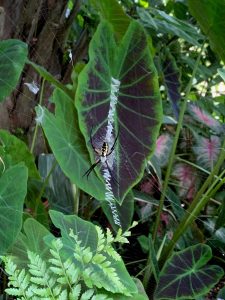
Garden spider waiting for a meal. Photo by Beth Bolles, UF IFAS Extension Escambia County.
As fall approaches each female garden spider leaves us a wonderful gift in the garden. She will create a very distintive egg sac that can be hidden in plants or hang in the corner of a porch. The sac is brown and pear shaped, supported by strands of web attached to branches or structures. Hundreds of eggs are inside and although they hatch in late fall, the spiderlings will stay in the sac until the spring. A large number of spiderlings will not survive due to predation and other factors, but a few will continue development to adorn your garden in the following season.
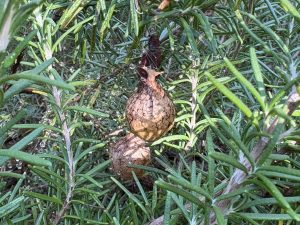
Egg sacs of the Yellow and black garden spider in a rosemary. Photo by Beth Bolles, UF IFAS Extension Escambia County.
If you did have a garden spider in your landscape this summer, just be a little more careful when maintaining plants. You don’t want to accidently remove the overwintering egg sac. Although this large spider can be startling for many people, they are not aggressive and are considered beneficial in the garden.
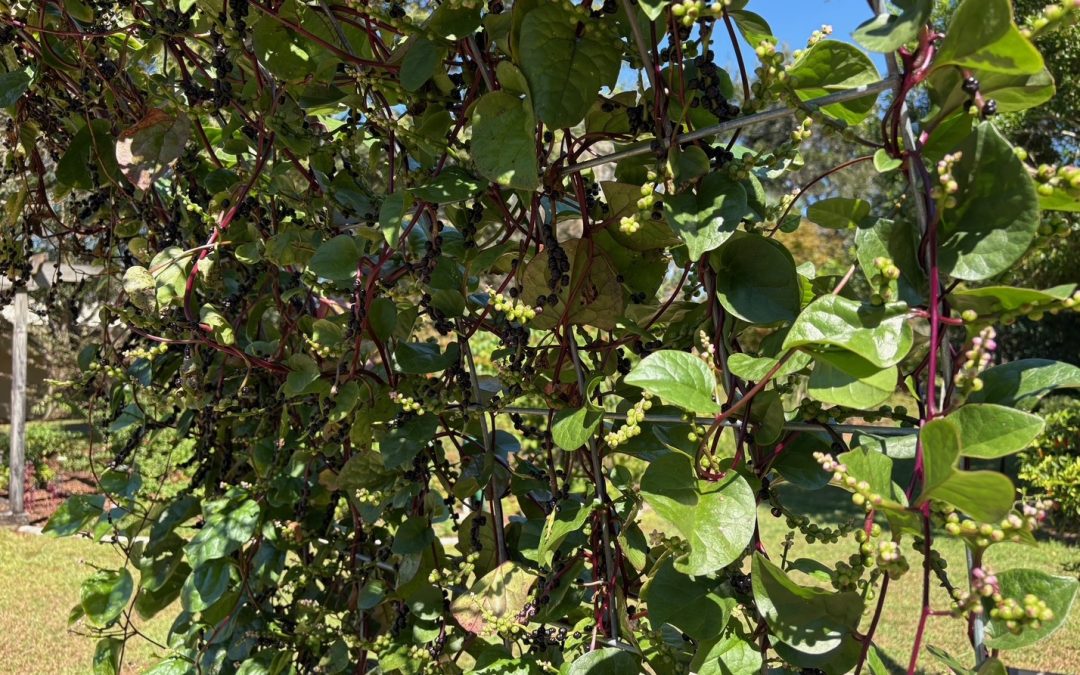
by Beth Bolles | Oct 17, 2025
Saving seeds is a wonderful garden activity that gives us both a sense of pride in our gardening skills and helps us save a few dollars on new seeds.
Malabar spinach is one of our heat loving vines that grows well until frost and produces abundant seed. If you are looking for a leafy green spinach substitute, Malabar spinach does very well in the summer garden. We had a late start on planting our Malabar spinach in the Escambia Extension garden so the seeds are now ripening. This is the perfect plant for saving seeds.
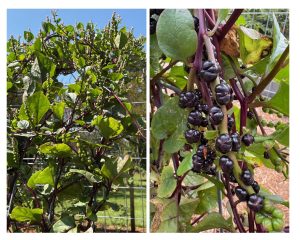
Vines growing along with mature fruit. Photos by Beth Bolles UF IFAS Extension Escambia County.
Malabar spinach has plenty of fruit for you to save seeds for yourself and friends. When mature, fruit will be dark purple and you may easily pull the fruit off stems into a small container. This is definitely a practice that requires gloves unless you want to have your hands stained purple for a while.
Your next step is to lightly press on the fruit while running them under water. Have a strainer underneath to catch the fruit. You are just trying to loosen some of the pulp, not remove every bit. Fill a small jar 3/4ths with water and then add your fruit. Let this sit on a counter for a few days. You may change out the water as needed. This is the step that loosens the remaining pulp from around the seeds.
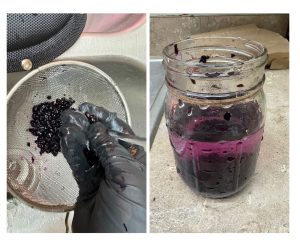
Loosening pulp from seeds and then soaking in water. Photos by Beth Bolles, UF IFAS Extension Escambia County.
After several days in the jar, pour the jar liquid through a strainer and wash over it with clean water. This removes the final bits of pulp. Place a paper towel or cloth on the counter and lay out your cleaned seeds. They will need to air dry for a couple of days. Keep seeds away from a heat source and out of the sun.
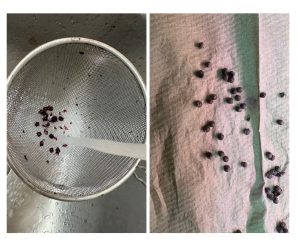
Final rinse of seeds and drying on towel. Photos by Beth Bolles, UF IFAS Extension Escambia County.
Once dry, you are ready to package your seeds for next season’s planting or gifts for friends. You may use a paper envelope or small plastic bag. You may also add seeds to a jar, close it tightly, and put in the refrigerator. Label your package with the plant and date because you will not remember those details later.
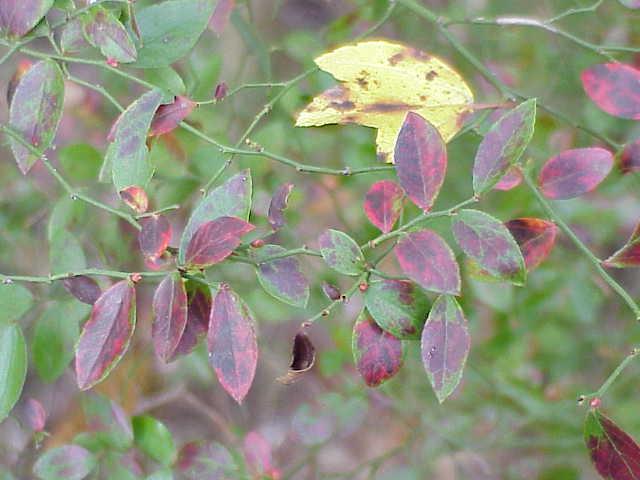
by Beth Bolles | Sep 18, 2025
Many gardeners enjoy plants that attract butterflies and there is no shortage of beautiful flowering plants to supply nectar for all our pollinators. One critical part of making habitat for butterflies that we may need to improve upon is supplying plenty of host plants for butterfly development. While we enjoy the flight of a butterfly through our garden, we really want to offer features that keeps them around.
Your landscape likely includes a few host plants and maybe you even have a citrus tree or plant parsley every season. What many people don’t realize is how many native trees serve as host plants for butterflies. Some of these plants like specific environments while others can grow in a wide variety of habitats.
The Black cherry (Prunus serotina) and Cherry laurel (Prunus caroliniana) serve as host to a large number of butterflies. A more well know species that uses the native cherries for development is the Tiger swallowtail. Although we might consider these trees weedy, they can serve as hosts to hundreds of species of butterflies and moths along with providing berries for wildlife. The black cherry will be deciduous while the cherry laurel is evergreen. Both have flowers in late winter or early spring. Just be aware that the cherry laurel fruit can have some toxicity in different developmental stages.
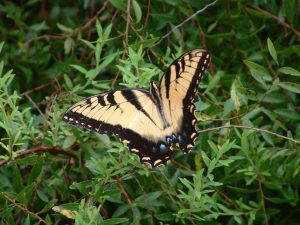
Yellow form of the Tiger Swallowtail. Some females can also have mostly black coloration to prevent predation. Photo: Beth Bolles, UF IFAS Extension Escambia County.
The Winged elm (Ulmus alata) is gaining in popularity as a landscape tree. The Question mark butterfly will lay eggs on plants under the elm and then caterpillars crawl up to feed on elm leaves. The reason we don’t see this butterfly on flowers as much is that it also feeds on manures, carrion, and rotting fruit. Resting butterflies have wing patterns that make them look like leaves.
If you have a site with moist soil or can supply routine moisture, consider the Sweet bay magnolia (Magnolia virginiana). It will attract the Tiger, Palamedes, and Spicebush swallowtails for development. Flowers on the tree are not as large as those on Southern magnolia but you still have similar appearance and even a pleasant fragrance.
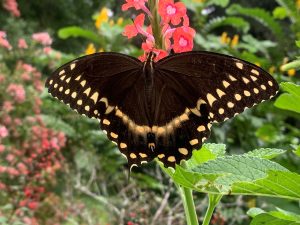
Palamedes swallowtail butterfly feeding on a porterweed. Photo by Beth Bolles, UF IFAS Extension Escambia County.
A couple of understory trees are the Pawpaw (Asimina triloba) and Sparkleberry (Vaccinium arboreum). Look for the Zebra swallowtail to find the Pawpaw while the sparkleberry will serve as host to hairstreak butterflies.
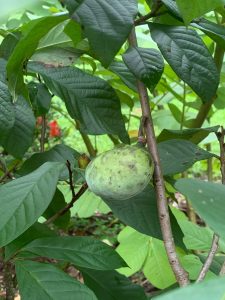
Pawpaw also offers delicious fruit. Photo by Beth Bolles, UF IFAS Extension Escambia County.
Even though landscapes may have limited spaces for every host plant, we can preserve some spaces around borders for native trees. These plants will make a positive impact for butterflies and pollinators.
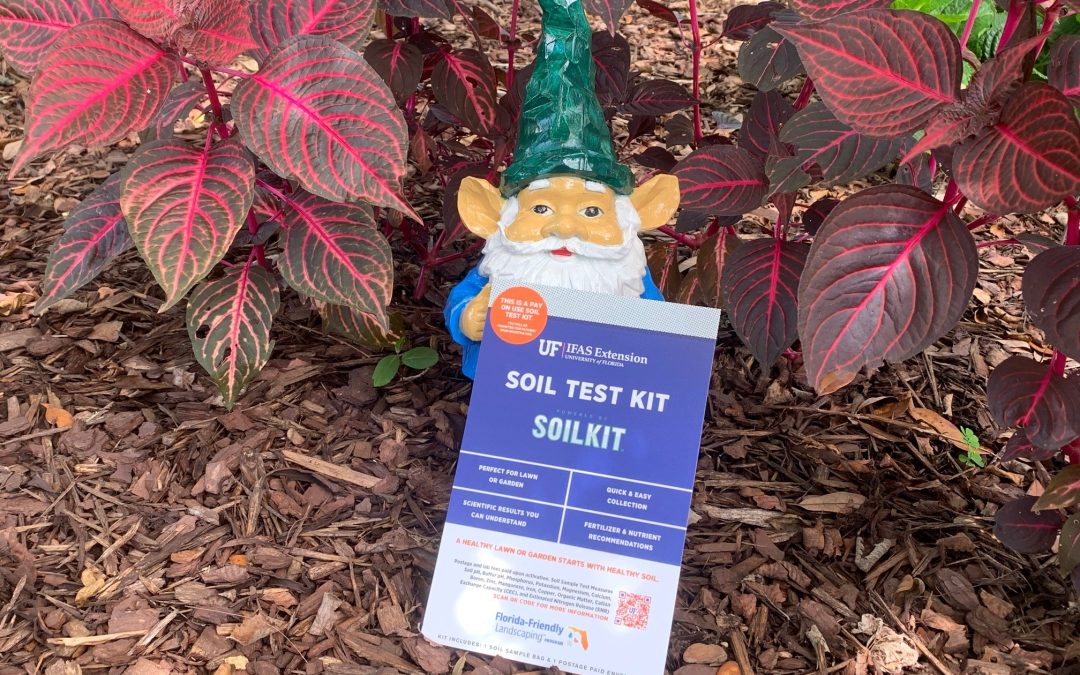
by Beth Bolles | Aug 9, 2025
You have probably heard about the SoilKit testing option that is available at local UF IFAS Extension offices. Why would you want to use a new testing kit when the traditional soil testing kit is still available ?
UF IFAS Extension SoilKit is an option for those who want their turfgrass test results based on the latest evidence-based science. This is especially important when dealing with the application of phosphorus, a potentially polluting nutrient. If your soil measures adequate phosphorus for our warm season turfgrasses, you don’t want to add more.
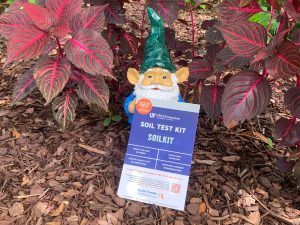
UF IFAS Extension SoilKit. Photo by Beth Bolles, UF IFAS Extension Escambia County.
The good news is that UF IFAS turfgrass research has established thresholds for when nutrients like phosphorus are needed. SoilKit is aligned with these thresholds and will only recommend nutrients based on the evidence-based science.
SoilKit does cost more than the traditional soil testing. The convenience is that it includes postage so you put it directly in your mailbox for pickup. Another positive is that when you register your kit online, you can locate your home on a map and mark the square footage of the lawn area. When you get your results in a few days, there is no guess work. You will get a list of products and amounts to purchase for your size lawn.
SoilKit can be used to test other plant groups including gardens and shrubs. If you have questions about using SoilKit, your local Extension office can help.















